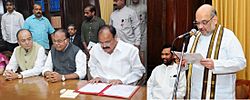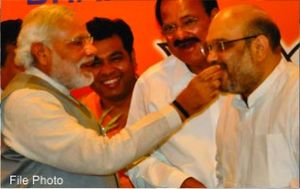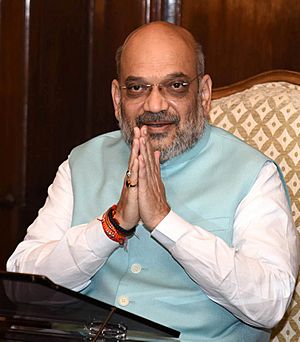Amit Shah facts for kids
Quick facts for kids
Amit Shah
|
|
|---|---|
 |
|
| 32nd Minister of Home Affairs | |
| Assumed office 30 May 2019 |
|
| Prime Minister | Narendra Modi |
| Preceded by | Rajnath Singh |
| 1st Union Minister of Cooperation | |
| Assumed office 7 July 2021 |
|
| Prime Minister | Narendra Modi |
| Preceded by | office established |
| Member of Parliament, Lok Sabha | |
| Assumed office 23 May 2019 |
|
| Preceded by | Lal Krishna Advani |
| Constituency | Gandhinagar, Gujarat |
| Majority | 744,716 (56.34%) |
| Member of Parliament, Rajya Sabha | |
| In office 19 August 2017 – 29 May 2019 |
|
| Preceded by | Dilip Pandya |
| Succeeded by | Subrahmanyam Jaishankar |
| Constituency | Gujarat |
| 3rd Chairperson of National Democratic Alliance |
|
| Assumed office 9 July 2014 |
|
| National President |
|
| Preceded by | L. K. Advani |
| 10th National President of Bharatiya Janata Party | |
| In office 9 July 2014 – 20 January 2020 |
|
| Preceded by | Rajnath Singh |
| Succeeded by | Jagat Prakash Nadda |
| Member of Gujarat Legislative Assembly | |
| In office 2012–2017 |
|
| Preceded by | constituency established |
| Succeeded by | Kaushik Patel |
| Constituency | Naranpura |
| In office 1997–2012 |
|
| Preceded by | Harishchandra Lavjibhai Patel |
| Succeeded by | constituency abolished |
| Constituency | Sarkhej |
| Minister of State, Government of Gujarat | |
| In office 2002–2010 |
|
| Departments | Home, Law and Justice, Prison, Border Security, Civil Defence, Excise, Home Guards, Transport, Prohibition, Gram Rakshak Dal, Police Housing, Legislative and Parliamentary Affairs |
| Chief Minister | Narendra Modi |
| Personal details | |
| Born |
Amit Anil Chandra Shah
22 October 1964 Bombay, Maharashtra, India (present-day Mumbai) |
| Political party | Bharatiya Janata Party |
| Other political affiliations |
National Democratic Alliance |
| Spouse |
Sonal Shah
(m. 1987) |
| Children | Jay Shah (son) |
| Residences | 6A, Krishna Menon Marg, New Delhi, Delhi, India |
| Alma mater | Gujarat University |
| Occupation | Politician |
Amitbhai Anilchandra Shah (born 22 October 1964) is an Indian politician. He is currently the Minister of Home Affairs for India, a role he has held since May 2019. He also became the first Minister of Co-operation in July 2021.
Mr. Shah is a Member of Parliament (MP) for Gandhinagar. He was the president of the Bharatiya Janata Party (BJP) from 2014 to 2020. He has also been the chairman of the National Democratic Alliance (NDA) since 2014. Before this, he was a member of the upper house of parliament, Rajya Sabha, representing Gujarat from 2017 to 2019. Amit Shah is known as a key planner for the BJP and a close supporter of Prime Minister Narendra Modi.
Shah also served as a member of the Gujarat Legislative Assembly for many years. He was a minister in the Gujarat government, holding important roles like Home, Law and Justice, and Transport from 2002 to 2012. During his college days, he was part of the Akhil Bharatiya Vidyarthi Parishad (ABVP), a student group linked to the Rashtriya Swayamsevak Sangh (RSS). He joined the BJP in 1987.
Shah was in charge of the BJP's campaign in Uttar Pradesh for the 2014 Lok Sabha elections. The BJP and its allies won many seats, which helped Shah become the party's national president in July 2014. He has helped the BJP win elections in many states since then.
Contents
Early Life and Education
Amitbhai Anilchandra Shah was born in Mumbai on 22 October 1964. He comes from a Gujarati Hindu family. His father, Anil Chandra Shah, ran a successful business.
He went to school in Mehsana and later moved to Ahmedabad. There, he studied biochemistry at CU Shah Science College. He earned a Bachelor's of Science (B.Sc.) degree in Biochemistry. After college, he worked in his father's business. He also worked as a stockbroker and in cooperative banks in Ahmedabad.
Shah was involved with the Rashtriya Swayamsevak Sangh (RSS) from a young age. He formally became an RSS volunteer during his college years. He first met Narendra Modi in 1982 through the RSS in Ahmedabad. At that time, Modi was an RSS leader working with youth groups.
Starting a Political Career
Joining Politics
Amit Shah began his political journey in 1982 by joining the Rashtriya Swayamsevak Sangh (RSS). Soon after, he met Narendra Modi, who suggested he join the student group of the RSS, the Akhil Bharatiya Vidyarthi Parishad (ABVP). Shah joined the ABVP in 1983.
He then joined the Bharatiya Janata Party (BJP) in 1987. He became active in the BJP's youth wing, Bharatiya Janata Yuva Morcha (BJYM). He moved up in the BJYM, holding various positions. He became known for his organizing skills when he managed the election campaign for Lal Krishna Advani in Gandhinagar during the 1991 elections.
Working in Gujarat
In 1995, the BJP formed its first government in Gujarat. Keshubhai Patel became the Chief Minister. At that time, the Indian National Congress was very strong in rural Gujarat. Modi and Shah worked together to reduce the Congress's influence in these areas. They found influential local leaders and encouraged them to join the BJP.
They used a similar plan to weaken Congress's control over the state's important co-operative banks. In 1999, Shah was elected president of the Ahmedabad District Cooperative Bank (ADCB), one of India's largest cooperative banks. The bank was losing a lot of money, but Shah helped it become profitable within a year.
Shah also worked to reduce Congress's influence over sports organizations in Gujarat. He became the president of the Gujarat State Chess Association. In 2009, he became the vice-president of the Gujarat Cricket Association (GCA). In 2014, after Modi became Prime Minister, Shah became the president of GCA.
Modi helped Shah get bigger roles in politics. Shah became the chairman of the Gujarat State Financial Corporation. In 1997, Shah won a by-election for the Gujarat Legislative Assembly in Sarkhej, becoming an MLA. He won this seat again in the 1998 Assembly elections.
Gujarat State Government Roles
In October 2001, Narendra Modi became the Chief Minister of Gujarat. Over the next few years, Modi and Shah worked closely together.
Shah won the 2002 and 2007 Assembly elections from the Sarkhej area. During Modi's time as Chief Minister, Shah became a very powerful leader in Gujarat. After the 2002 elections, he became one of the youngest ministers in Modi's government. He held many important jobs at once, including Home, Law and Justice, and Transport.
Shah also helped pass important laws in Gujarat, such as the Gujarat Freedom of Religion Bill, which made religious conversions more difficult.
Rise in National Politics
Leading the 2014 Election Campaign
When Modi became the BJP's candidate for Prime Minister, Shah's influence grew. He was appointed as a BJP general secretary and put in charge of Uttar Pradesh (UP). This was a big responsibility, as UP is a very important state for elections.
Shah's political career became even stronger after the BJP won the 2014 Indian general election. In Uttar Pradesh, where Shah was in charge, the BJP and its allies won 73 out of 80 seats. Shah had spent a lot of time in Uttar Pradesh, understanding the voters and planning the campaign.
He focused on choosing candidates who were popular locally. His team also worked hard on door-to-door campaigning, reaching out to voters at every polling booth. They used special mobile vans to reach people in remote areas. Shah visited many constituencies himself.
Shah also encouraged Modi to use RSS volunteers for campaigning, which helped the BJP greatly. These volunteers helped organize and monitor the campaign efforts.
BJP President (2014–2019)
In July 2014, Amit Shah was chosen as the president of the BJP. He was re-elected in January 2016. As president, Shah started a big campaign to get more members for the party. By March 2015, the BJP claimed to have 100 million members.
From 2014 to 2016, the BJP won state elections in Maharashtra, Haryana, Jammu and Kashmir, Jharkhand, and Assam. However, they lost elections in Delhi and Bihar.
Shah continued to lead the BJP in the 2017 state elections. The party had great success in Uttar Pradesh and Uttarakhand, winning many seats. The BJP also did well in Manipur and won the Gujarat and Himachal Pradesh elections. In March 2018, the BJP won in Tripura for the first time.
Under Shah's leadership, the BJP won a majority in the 2019 Indian general election. He visited many constituencies, holding public meetings and roadshows. He set a goal for the BJP to win over 300 seats, which they achieved. This made the BJP the leading political party in India.
Shah is often compared to Chanakya, an ancient Indian strategist, because of his skill in political planning.
Union Cabinet Minister (2019–Present)
Minister of Home Affairs

Amit Shah became a Cabinet Minister on 30 May 2019 and took office as the Minister of Home Affairs on 1 June 2019.
Key Decisions
On 5 August 2019, Shah proposed a plan to change Article 370, which gave special status to Jammu and Kashmir. This change led to the state being divided into two union territories: Jammu and Kashmir, and Ladakh.
In September 2019, Shah spoke about the importance of the Hindi language for uniting India. He encouraged people to use Hindi more often.
In March 2024, Amit Shah mentioned that the government might consider removing the Armed Forces (Special Powers) Act in Jammu and Kashmir.
New Laws
On 19 November 2019, Shah announced that the National Register of Citizens (NRC) would be put into effect across the country. This is a record of all legal citizens.
In December 2019, he introduced the Citizenship (Amendment) Act, 2019. This law offers Indian citizenship to certain minority groups who came to India before 2015 from Pakistan, Bangladesh, and Afghanistan due to religious persecution.
The Criminal Procedure (Identification) Bill 2022 was also introduced. This bill allows police and prison officials to collect and store physical and biological information, like fingerprints and iris scans, from people who have been arrested or convicted. Shah stated that this law would help in solving crimes by providing more evidence.
Election Results
Since 1989, Amit Shah has participated in many elections for various local government positions.
| Election | Year | Constituency | Result | Votes | % of votes |
|---|---|---|---|---|---|
| Gujarat Legislative Assembly (by-election) | 1997 | Sarkhej | Won | 76,839 | 56.10% |
| Gujarat Legislative Assembly | 1998 | Sarkhej | Won | 193,373 | 69.81% |
| Gujarat Legislative Assembly | 2002 | Sarkhej | Won | 288,327 | 66.98% |
| Gujarat Legislative Assembly | 2007 | Sarkhej | Won | 407,659 | 68.00% |
| Gujarat Legislative Assembly | 2012 | Naranpura | Won | 103,988 | 69.19% |
| Indian general election | 2019 | Gandhinagar | Won | 888,210 | 69.76% |
| Indian general election | 2024 | Gandhinagar | Won | 10,10,972 | 76.5% |
Personal Life
Amit Shah is married to Sonal Shah. They have a son named Jay Shah. He also has six sisters. His mother passed away in June 2010.
In September 2019, he had a small operation for a lipoma on his neck. In August 2020, he tested positive for COVID-19 and was admitted to the hospital.
See also
- Third Modi ministry






